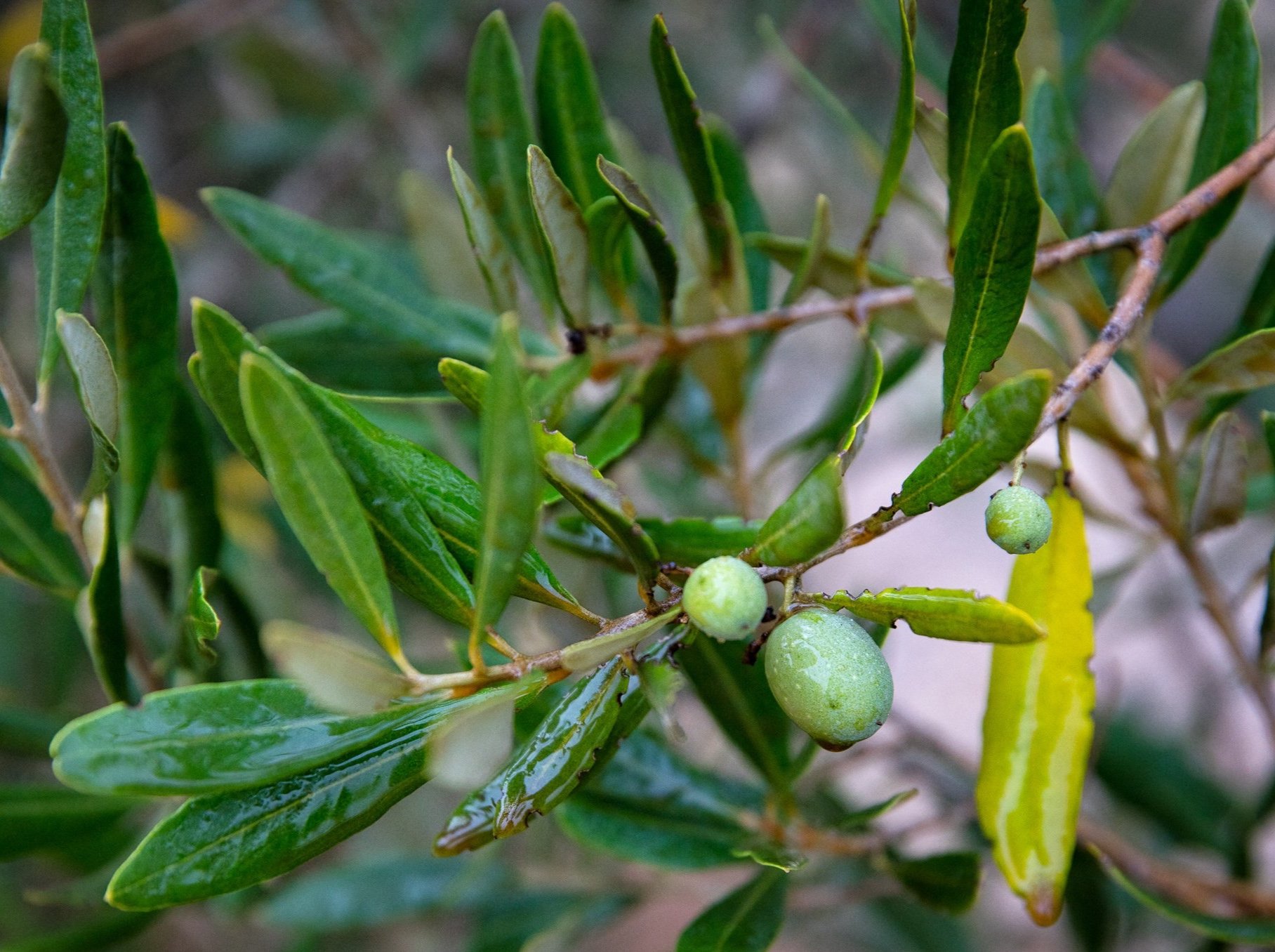
Other Insect Pest Control
Besides the olive fly, there are a number of insect and mite pests that can attack olive trees. They generally can be kept below economically damaging levels through a combination of biological and cultural controls. It is important to take care of problems when needed before secondary infestation and damage can occur. When making decisions on when pesticides are necessary and choosing control measures, it is best to take an integrated pest management control approach and to take into consideration the possible secondary effects on the environment.
Following is some basic information about how to identify various insects. We give a quick description of the pest and the type of damage, and give you a link to the UC Integrated Pest Management (UC IPM) page for more details and for treatment options and risks. We also recommend the book from Paul Vossen as well as the book from Ferguson and Sibbett, all listed in our Sources below. Keep in mind that you must be certified to apply most insecticides and, for all insecticides, if you are a commercial grower. See the California Department of Pesticide Regulation for more information.
AMERICAN PLUM BORER
The American Plum Borer infests olive trees on occasion. The adult moth is gray with a wing expanse of 0.75 to 1” (19 to 25mm) and brown and black markings on the wings. The larvae attack soft, spongy, callus-like tissue, which occurs at graft unions, tree wounds, and in olive knots. They can continue to feed into normal tissue, girdling limbs and causing small branches to break. The borer can be detected by the brownish frass (excrement of the larvae) and webbing at the feeding sites.
For more information and control recommendations, see the UC IPM American Plum Borer.
BLACK SCALE
Black scale adult females are about 0.2” (5mm) in diameter and dark brown or black with a prominent H-shaped ridge on the back. Young scales are yellow or orange crawlers and are found on leaves and twigs of tree. A hand lens is usually needed to detect the crawlers. Black scale prefers dense, un-pruned portions of trees. Open, airy trees rarely support populations of black scale.
The detection is fairly easy because young black scales excrete sticky, shiny honeydew on leaves of infested trees. At first, affected trees and leaves glisten and then become sooty and black in appearance as sooty mold fungus grows on the honeydew.
For more information and control recommendations, see the UC IPM Black Scale.
BRANCH AND TWIG BORER
The branch and twig borer adult is a 0.3 to 0.6” (7 to 15mm) long beetle, mostly black with brown wing covers. The C-shaped, white larvae are covered with fine hair.
Adults bore small, round holes at the base of buds or axils of twigs injured by sunburn. Twigs break at the location of the injury. Loss of a few small branches in an orchard is of little consequence to production. But they can proliferate to the point of doing significant damage.
For more information and control recommendations, see the UC IPM Branch and Twig Borer.
CALIFORNIA RED SCALE
An armored scale, the California red scale resembles a small encrustation on the plant. The adult female has a thin, circular shell, 0.10” (2.5mm) in diameter. The reddish body color is visible through the shell. When mature, females produce 100 to 150 eggs. Crawlers hatch and emerge from under the female cover at a rate of two to three per day. Crawlers move around to find a suitable place to settle and can be spread about by wind, birds, or picking crews.
California red scale does not discolor fruit, which distinguishes its damage from that of olive scale and oleander scale. All parts of the olive tree can be infested. Infested fruit are rendered worthless.
The California red scale can be monitored by examining fruit, twigs, and leaves for scales, or by applying double-sided sticky tape to branches and examining it for crawlers.
For more information and control recommendations, see the UC IPM California Red Scale.
GREEDY SCALE AND LATANIA SCALE
The greedy scale and the latania scale are armored scales and similar in size to adult olive scale and oleander scale. However, the waxy shell covering of these two species is more conical with a small black spot or nipple to one side of the center. If the shell is removed, the female body is yellow, unlike the reddish purple body of the olive scale. The male scale body is much smaller and elongated. It is difficult to distinguish between latania and greedy scales without a microscope, but management for the two species is the same.
These scales feed on leaves, bark, and fruit. Infested fruit have a dark purple spot with a distinct outline. The scale is located in the center of the spot. Fruit with scale are rendered worthless.
For more information and control recommendations, see the UC IPM Greedy Scale and Latania Scale.
OLEANDER SCALE
The adult female oleander scale is an armored scale that is about 0.1” (2.5mm) long and oval. It has a waxy covering that is whiter than olive scale with a yellow or light brown spot near the center. The adult male scale is elongate. If the coverings are removed, the female body is yellow, while the male scale is brownish yellow. This scale is most common on leaves in the lower part of the tree.
The oleander scale infests the olive fruit and delays maturity at the spot where it feeds. Damage is seen as prominent green spots on purple fruit, in direct contrast to the dark spots caused by olive scale. Heavy infestations seriously deform fruit, and fruit spotting renders the olive worthless. Extremely heavy infestations reduce oil content by as much as 25%. Leaf and twig damage also result in lost production.
For more information and control recommendations, see the UC IPM Oleander Scale.
OLIVE MITE
The olive mite occurs throughout all commercial olive districts in California. Susceptibility varies among cultivars. Among California varieties, Ascolano is the most at risk. The olive mite is an eriophyid mite and is difficult to see without magnification. The mite is yellowish to dark tan, slow moving, and has a wedge-shaped body. As a rule, this pest is not a major problem. Olive mites feed on succulent stem and bud tissues and on the upper surface of leaves. Gross symptoms of mite damage include sickle-shaped leaves, dead vegetative buds in spring, discoloration of flower buds, bud drop, blossom blasting, inflorescence abscission, and reduced shoot growth.
For more information and control recommendations, see the UC IPM Olive Mite.
OLIVE SCALE
Olive scale is an armored scale and like all armored scales, resembles a small encrustation on the plant. The adult female scale is about 0.10” (2.5mm) long, with a grayish, oval, waxy covering. The male scale is more elongate with a black spot at one end. If the coverings are removed, the scale bodies of both sexes are reddish purple. Olive scale feeds on twigs, leaves, and fruits. However, it is most often noticed at harvest; dark purple spots occur on otherwise green to yellowish fruit where the scale has settled.
Early in the growing season (late May and June) first brood olive scale feed on and consequently deform young, rapidly growing fruit. A later brood, in July and August, causes the pronounced purple spotting of green fruit, rendering it worthless for most markets except perhaps black ripe process. Heavy olive scale infestations will also occur on branches, twigs, and leaves. Such infestations substantially reduce the productivity of a tree.
For more information and control recommendations, see the UC IPM Olive Scale.
OLIVE PSYLLID
The light green and tan adults are about 1” (2.5mm) long and strong jumpers. In olive trees, they do not move very far, leading to clumped distributions. Forewings are marked with a few small dark spots. Nymphs are flat, green to tan, and secrete a white waxy coating that covers the entire colony. There are five nymphal stages, 0.01 to 0.06” (0.4 mm to 1.5 mm) long. The eggs are elliptical, tiny (less than 0.01” (0.3mm) long), pale yellow, and attach to the substrate by a pedicel.
The olive psyllid damages trees through direct feeding on buds, flowers, tender shoots, and small fruit and also through the production of honeydew, which increases sooty mold development. During olive flowering and fruiting, psyllid waxy secretions cause flower and small fruit drop and yield reductions. Large populations may retard the growth of young trees. Trees that are heavily infested can have yield losses of 30 to 60%.
For more information and control recommendations, see the UC IPM Olive Psyllid.
ROOT WEEVILS
Cribate weevil adults are dark brown with longitudinal striations. The adult black vine weevil is black with small patches of white scales. Both are about 0.5” (12.7mm) long. They are flightless and nocturnal. The adults, nearly all females, emerge in late spring or early summer. Larvae are white, legless grubs, with distinct brown heads that feed on tree roots.
Adults feed on foliage and scallop leaf edges. Leaf damage is a good indication that weevils are present, but is not harmful to established trees. Adult feeding may cause economic damage to young or newly grafted trees. Root feeding of larvae has not been associated with damage to olives.
For more information and control recommendations, see the UC IPM Root Weevils.
WESTERN FLOWER THRIPS
Western flower thrips are tiny insects about 0.05” (1mm) long, with two pair of fringed wings. Adults vary in color from white to yellow with slight brown spots on the top of the abdomen, to yellowish with an orange thorax and brown abdomen, to completely dark brown. Different color forms predominate according to the time of year.
Eggs are inserted into leaves, flower parts, and fruit. First-instar nymphs are light yellow, turning golden yellow after the first molt. When they are ready to pupate, nymphs drop to the ground and pupate in protected places.
Western flower thrips migrate into olives after adjoining grasses dry up in spring, causing serious damage to fruit. Ascolano is most susceptible, although other cultivars can be damaged. Developing fruit is scarred and dimpled by thrips feeding.
For more information and control recommendations, see the UC IPM Western Flower Thrips.
SOURCES
UC IPM Pest Management Guidelines.
G. Steven Sibbett and Louise Ferguson: Olive Production Manual, University of California.
Paul M. Vossen: Organic Olive Production Manual, University of California.
UC Integrated Pest Management Program - Relative Toxicities of Insecticides and Miticides Used in Olives to Natural Enemies and Honey Bees.
